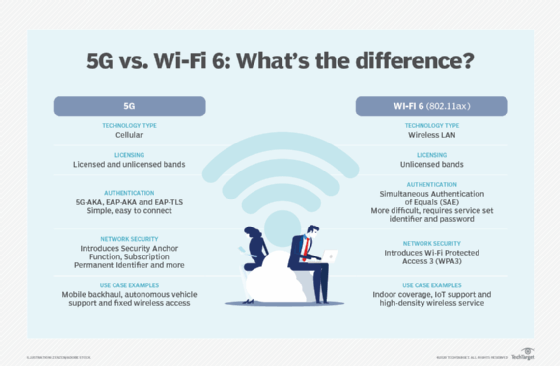Cellular and wireless technology evolves every few years, with new generations promising improved functionality and new use cases. So are the latest cellular and wireless generations, 5G and Wi-Fi 6, respectively.
In the wireless world, Wi-Fi 6 aims to stand out from past generations by bringing a new generation naming system, enhanced IoT capabilities, and multi-user support. For cellular, 5G introduces network speeds and data rates and low latency not seen with previous cellular technologies.
Although Wi-Fi 6 and 5G differ in some ways, experts suggest the two technologies work well together to support enterprise use cases such as IoT, edge computing, and remote work. .
Wi-Fi 6 and 5G definitions
Wi-Fi6
Wi-Fi 6, also known as 802.11ax, is a wireless standard defined by the IEEE. The Wi-Fi Alliance introduced a new naming system in 2018 that aims to clarify different Wi-Fi generations using numerical sequences. For example, the previous 802.11n and 802.11ac standards are known as Wi-Fi 4 and Wi-Fi 5, respectively.
Wi-Fi 6 builds on the features of previous generations, but aims to improve efficiency and speed. Wi-Fi 6 also supports features such as orthogonal frequency division multiple access (OFDMA) and multi-user multiple-input multiple-output (MU-MIMO). Both OFDMA and MU-MIMO enable multi-user support and improve performance, capacity, and reliability.
5G
5th Generation Wireless is the latest generation of cellular technology. 5G will go beyond 4G LTE with improved network speeds and reliability. 5G uses higher frequencies than 4G LTE, allowing for faster data transfer and better support for real-time communications.
Wi-Fi 6 and 5G have the common goal of increasing bandwidth and network speeds and reducing latency. Both aim to improve upon their respective previous generations and provide better UX. However, the two technologies have important differences that allow them to complement each other and provide organizations with alternative connectivity options.

Differences between Wi-Fi 6 and 5G
The main differences between Wi-Fi 6 and 5G are:
- technology type.
- license.
- frequency.
- certification.
- network security.
- Fee.
- Example of use.
Type of technology
Many of the differences between Wi-Fi 6 and 5G are due to different types of technology. 5G is a cellular technology that uses base stations, small cells, and radio signals to transfer data and provide connectivity to end-user devices. 5G typically covers a large geographical area. Wi-Fi is a wireless LAN technology that uses routers, access points, and wireless signals to connect devices within a limited range.
license
Mobile phone technology is carrier-based, and this also applies to 5G technology. This means that carriers run their cellular networks on licensed spectrum bands, which exist to prevent interference between connected devices. In contrast, Wi-Fi operates in unlicensed bands that do not require permission to use.
However, 5G differs from previous mobile phone generations in this respect by operating in both licensed and unlicensed bands. This can cause interference between 5G and Wi-Fi 6 signals that are close to each other and requires special planning during deployment to avoid interference.
frequency
5G carriers are using different frequency bands for their mobile networks, including 600 MHz, 800 MHz, and mmWave operating between 30 GHz and 300 GHz. Wi-Fi 6, on the other hand, operates in the unlicensed spectrum of 2.4 GHz and 5 GHz. Wi-Fi 6E, an extension of Wi-Fi 6, operates at 6 GHz.
certification
Although permission is not required to use the unlicensed spectrum of Wi-Fi technology, permission is required to access the Wi-Fi network itself. To access a Wi-Fi network, users typically require a service set identifier (network name) and password. Additionally, Wi-Fi 6 introduces a new authentication type called Simultaneous Authentication of Equals to further protect against malicious actors.
Cellular networks don’t have the same authentication requirements as Wi-Fi networks, making access simple and easy for connected devices. However, 5G also uses several authentication types to enhance 5G network security, including 5G Authentication and Key Agreement, Extensible Authentication Protocol AKA, and EAP Transport Layer Security.
network security
Security has become a major concern for 5G due to the potentially high cost of securing 5G networks and increasing concerns about vulnerabilities. However, 5G introduces several security concepts, such as security anchor functionality, subscription persistent identifiers, and subscription hidden identifiers. These features enable seamless and secure re-authentication of connected devices as they move between networks, something that could not be guaranteed with previous mobile phone generations.
Wi-Fi network security has traditionally been easier to ensure for devices than cellular networks, and Wi-Fi 6 aims to further strengthen this. Wi-Fi Protected Access 3 (WPA3) supports Wi-Fi 6 security. WPA3 enhances authentication security and encryption, while also improving the shortcomings of its predecessor, WPA2.
Fee
Wi-Fi is usually cheaper to build and use. There are no license fees to use unlicensed spectrum, and Wi-Fi devices are typically more affordable than other networking equipment. 5G offers faster connectivity, but at a higher price. Most carriers will have to build their 5G infrastructure from scratch, which requires significant investment in equipment and components. You will also need to purchase spectrum for your mobile network.
Use Case
Another key difference between Wi-Fi 6 and 5G is where and how organizations deploy cellular and Wi-Fi technologies. Traditionally, Wi-Fi has been suited for indoor wireless coverage, and Wi-Fi 6 maintains this. Other Wi-Fi 6 use cases include enhanced support for IoT-connected devices and high-density wireless services for locations such as stadiums and sports venues.
When it comes to cellular, 5G is well-suited for outdoor use cases such as supporting self-driving cars. 5G also supports mobile backhaul, fixed wireless access, satellite pairing, and edge computing use cases. Organizations using 4G LTE for backhaul use cases can move to 5G to not only improve connectivity but also bring cellular into the fixed wireless space.

Wi-Fi 6, 5G as complements, not competitors
Although there are differences between Wi-Fi 6 and 5G, the two technologies work well together. Companies should focus less on which technology is better and more on how Wi-Fi 6 and 5G work together. More importantly, users likely don’t care what technology they use, as long as the connection is reliable.
Interoperability between Wi-Fi and 5G networks could provide seamless connectivity as users move between networks. Connected devices such as smartphones and laptops now support both technologies.
The combination of Wi-Fi 6 and 5G enables the growth of IoT and the success of network innovations such as edge computing. You can also better support remote workers and improve overall network connectivity with speed, reliability, and flexibility.
Editor’s note: This article was originally published by Michaela Goss and has been updated by our editors to reflect changes in the industry and improve the reader experience.


